YOU CAN'T PLAY A SYMPHONY ALONE
Instruments of the Orchestra
Introduction | Background Knowledge | Activities | Extensions | Standards
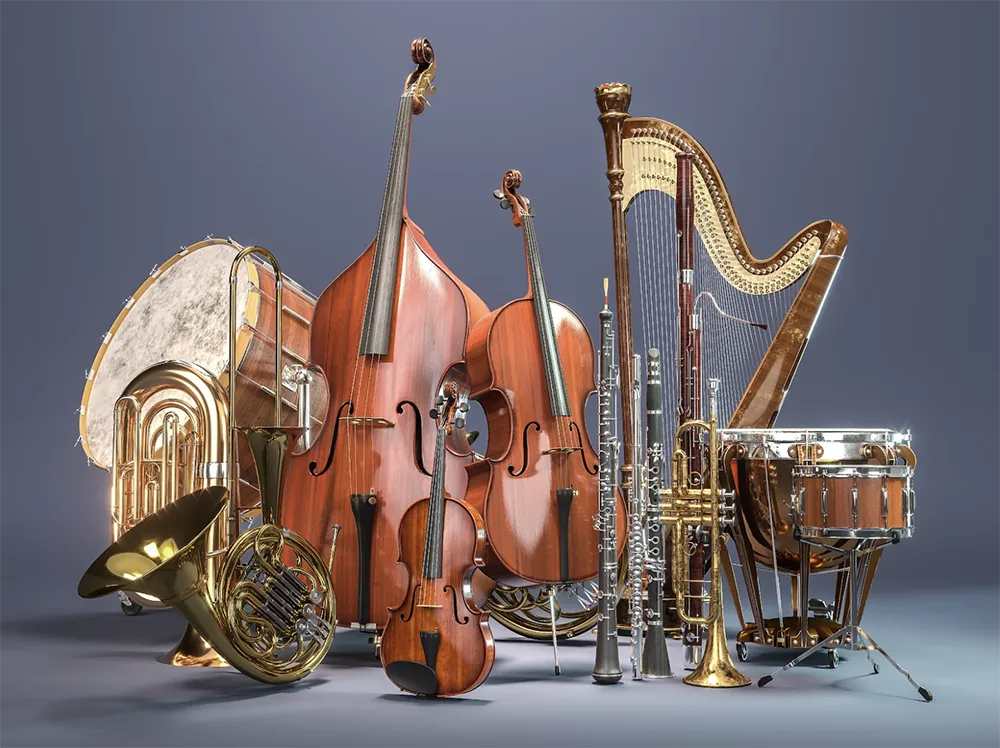
Introduction
Some of the orchestra's instruments are more recognizable than others, but each one is a vital part of the ensemble. From the tiny piccolo to the massive tuba, each instrument provides a sound and color that blend to create the full sound and beautiful music in the orchestra.
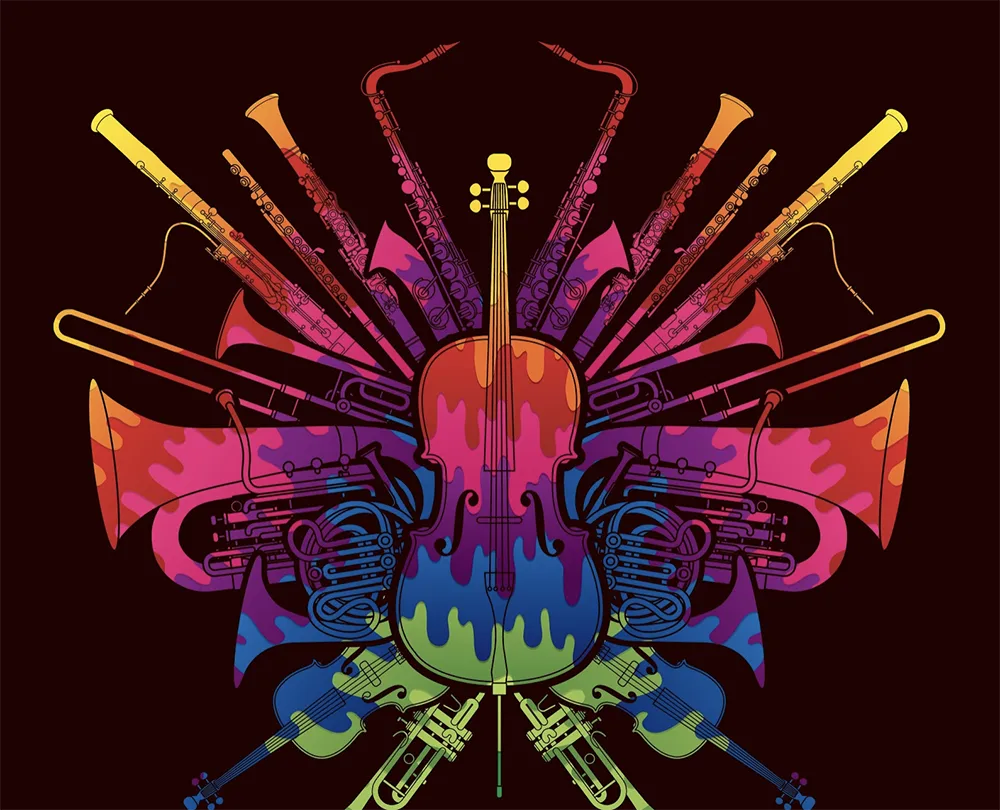
Background Knowledge
Instruments in the orchestra are divided into families. The families are separated by how they are played. Instruments in a family can be smaller or larger but often look similar to one another.
The most prominent instrument family in the orchestra is the strings family. These instruments are often seated in the front rows, closest to the conductor with the smallest instruments to the left and the larger instruments to the right. Stringed instruments are made of wood, and the strings vibrate to create sound. Players can play different pitches by changing the length of the strings. The strings are usually vibrated with a bow made of horse hair. Stringed instruments include the violin, viola, cello, and bass. The violin plays the highest notes and is the smallest, while the bass plays the lowest notes and is the largest. The harp is also a stringed instrument, and the strings are played by plucking with the fingers. The harp can typically be found in the back left of the orchestra. The principal violinist, or the best violin player in the orchestra, is known as the Concertmaster. This musician sits in the first chair of the front row to the left of the conductor. This person will play any violin solos in the piece. The Concertmaster also ensures that the orchestra is properly tuned before the music begins.
The next section in the orchestra is the woodwinds section. These players are in the middle of the orchestra, centered behind the violins and violas. Woodwinds were originally made of wood that air moved through. Modern woodwinds can be made of wood, metal, or plastic. Most of the winds are played with reeds, or small pieces of wood, that vibrate when it is blown across. The musician presses keys on the instrument to change the pitch. Woodwind instruments include the flute, clarinet, oboe, and bassoon. The alto saxophone is also considered a woodwind, even though it is made of brass because it is played with a single reed. It is not usually found in a concert orchestra as many famous composers did not write for saxophone but will be in jazz bands or holiday pieces.
The brass section of the orchestra sits at the back of the ensemble. Brass instruments are made of brass and have metal, cup-shaped mouthpieces. Musicians make sound by buzzing their lips into their mouthpieces and changing pitches with valves on the instrument. The instruments themselves are long pipes that are curved in various ways. Brass instruments make a sound that is bright and powerful. Instruments include the French horn, trumpet, trombone, and tuba.
Finally, at the back of the orchestra is the percussion family. Percussion instruments create sound when they are hit, shaken, or scraped. Some members of the percussion family are tuned and play pitched notes, such as the xylophone, timpani, and piano. Others do not have a definite pitch, such as the cymbals, castanets, or bass drums. The percussion family has the most instruments in the orchestra with the least number of musicians. Percussion musicians often play more than one instrument, sometimes playing many in a single song.
Each of these families has a different way of producing sound and each family produces a distinct sound. They all work together to create beautiful music that the world's composers wrote.
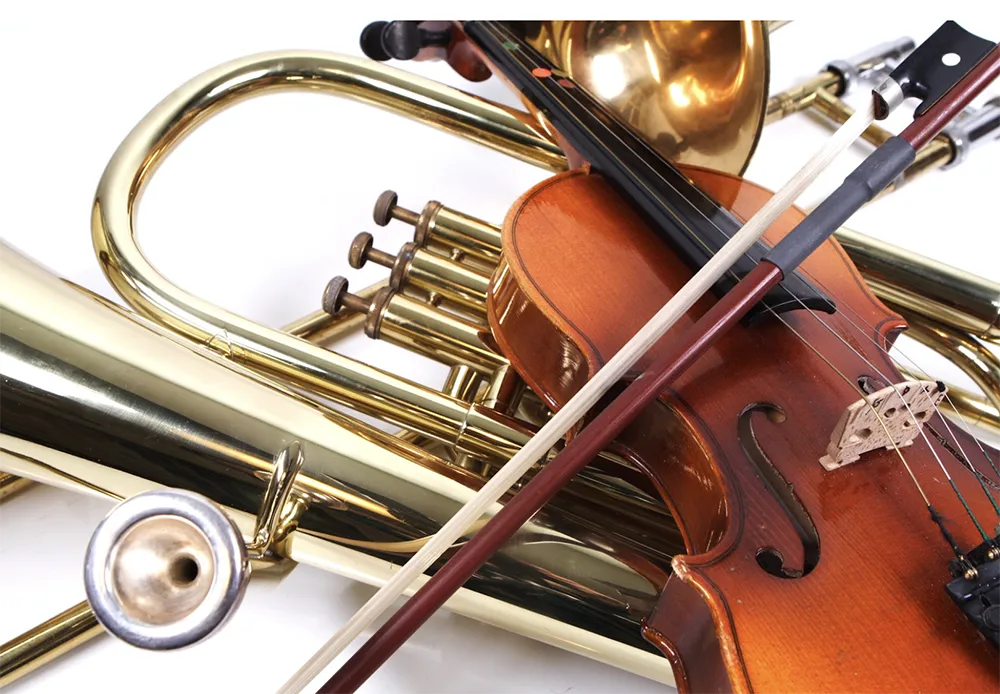
ACTIVITIES
-
This Magical, Musical Night
by Rhonda Gowler Greene
(ISBN 978-1499811728)
- This lively, rhyming book introduces readers to the instruments and instrument families of the orchestra. Basic musical terminology is also introduced.
- Watch The Young Person’s Guide to the Orchestra. This short snippet of Benjamin Britten’s longer piece points out the different sections of the orchestra and is a great companion to the book. For the full piece, enjoy this video from the New Jersey Symphony.
-
The Remarkable
Farkle
McBride by John Lithgow (ISBN
978-0689833403)
- Farkle McBride tries all of the instruments in the orchestra before deciding that being the conductor is the best.
- Have a ball learning about the orchestra’s instruments with Pitch Perfect (TeachersFirst review) from The Kennedy Center.
-
The Oboe Goes Boom, Boom,
Boom by Colleen AF Venable
(ISBN 978-0062494375)
- This book uses beautiful, descriptive language to help students find the perfect instrument.
- Play the instruments in the orchestra at Inside the Orchestra. Hear the sound of each instrument and play matching and memory games.
-
Symphony Storytime from the
Oregon Symphony
- Join the principal instrumentalists of the Oregon Symphony as they play soundtracks to popular children’s books.
- After watching videos shared on this site, ask students to “paint” their own music using Paint with Music from Google Arts and Culture (TeachersFirst review). This activity allows students to interact with the emotions created by music in addition to listening to the stories.
-
I Know A Shy Fellow Who
Swallowed a Cello by Barbara
Garriel (ISBN 978-1590789469)
- In the style of the “I know an old lady…”, the shy fellow starts to swallow orchestra instruments. The story takes a hilarious twist when he swallows the bell. Perform a Readers Theater with students providing the sounds of each instrument.
- If possible, have an instrument show and tell. Invite middle school or high school band members (if feasible) to come to show off their instruments.
- Take advantage of the many free digital resources the Kennedy Center provides (TeachersFirst review) to help students learn about the orchestra through different subjects and media types including podcasts, audio presentations, and more.
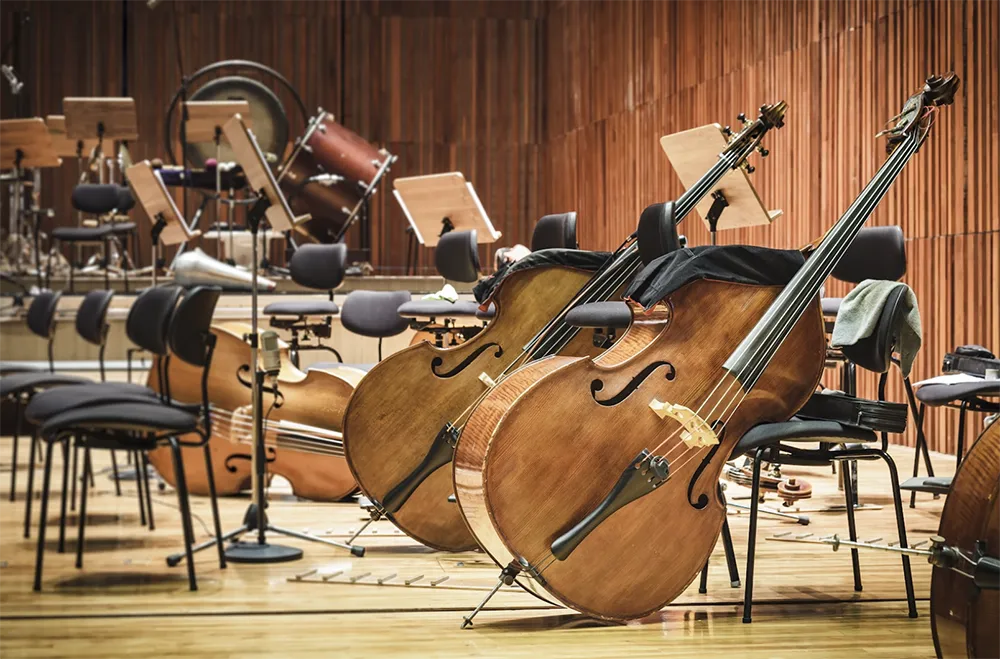
EXTENSION
- Samuel and the Dolphin
-
Read Peter and the
Wolf by
Janet Schulman (ISBN
978-0375824302).
- Have students reimagine Peter and the Wolf. Assign instruments to new animals and tell a new story. Visit DSO Kids (TeachersFirst review) to listen to sample sounds and learn about instruments played in the orchestra as students decide how to assign different instruments.
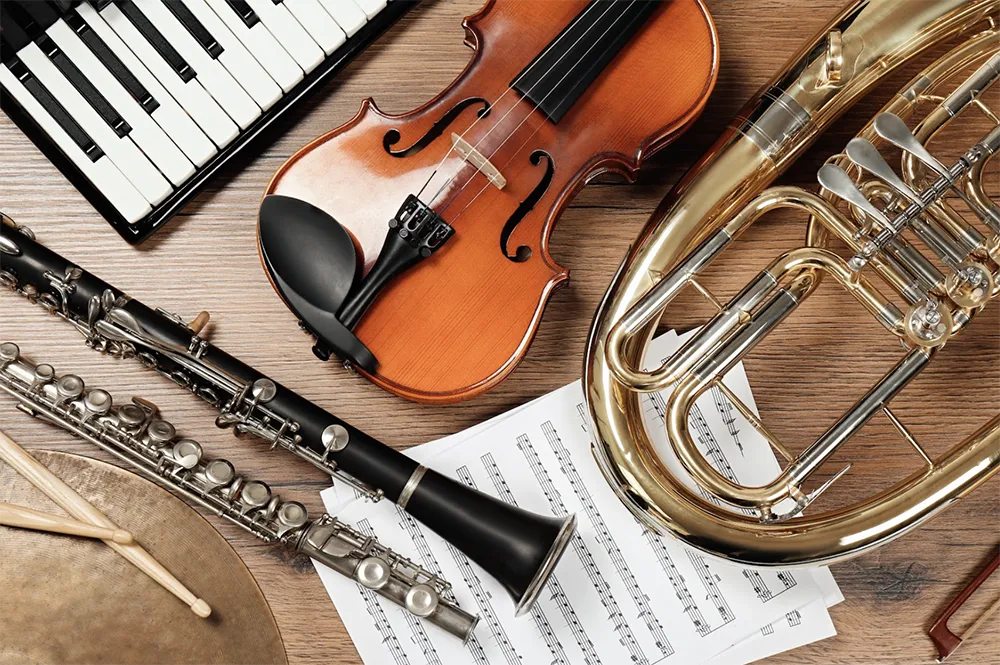
CORRELATION TO STANDARDS
-
AASL National School Library
Standards
- Inquire Shared Foundation, Think Domain - Learners display curiosity and initiative by: 1. Formulating questions about a personal interest or a curricular topic. 2. Recalling prior and background knowledge as context for new meaning
- Inquire Shared Foundation, Share Domain - Learners adapt, communicate, and exchange learning products with others in a cycle that includes: 1. Interacting with content presented by others. 2. Providing constructive feedback. 3. Acting on feedback to improve. 4. Sharing products with an authentic audience.
- Include Shared Foundation, Share Domain - Learners exhibit empathy with and tolerance for diverse ideas by: 1. Engaging in informed conversation and active debate. 2. Contributing to discussions in which multiple viewpoints on a topic are expressed.
- Include Shared Foundation, Grow Domain - Learners demonstrate empathy and equity in knowledge building within the global learning community by: 1. Seeking interactions with a range of learners.
- Collaborate Shared Foundation, Think Domain - Learners identify collaborative opportunities by: 1. Demonstrating their desire to broaden and deepen understandings. 2. Developing new understandings through engagement in a learning group. 3. Deciding to solve problems informed by group interaction.
- Collaborate Shared Foundation, Create Domain - s Learners participate in personal, social, and intellectual networks by: 1. Using a variety of communication tools and resources. 2. Establishing connections with other learners to build on their own prior knowledge and create new knowledge.
- Collaborate Shared Foundation, Grow Domain - Learners actively participate with others in learning situations by: 2. Recognizing learning as a social responsibility.
- Explore Shared Foundation, Think Domain - Learners develop and satisfy personal curiosity by: 1. Reading widely and deeply in multiple formats and writing and creating for a variety of purposes.
- Explore Shared Foundation, Create Domain - Learners construct new knowledge by: 1. Problem solving through cycles of design, implementation, and reflection.
- Explore Shared Foundation, Share Domain - Learners engage with the learning community by: 3. Collaboratively identifying innovative solutions to a challenge or problem.
- Explore Shared Foundation, Grow Domain - Learners develop through experience and reflection by: 1. Iteratively responding to challenges. 2. Recognizing capabilities and skills that can be developed, improved, and expanded. 3. Open-mindedly accepting feedback for positive and constructive growth.
-
ISTE Standards for Students
- Empowered Learner - 1b. Students build networks and customize their learning environments in ways that support the learning process. 1c. Students use technology to seek feedback that informs and improves their practice and to demonstrate their learning in a variety of ways.
- Knowledge Constructor - 3d. Students build knowledge by actively exploring real-world issues and problems, developing ideas and theories, and pursuing answers and solutions.
- Innovative Designer - 4d. Students exhibit a tolerance for ambiguity, perseverance, and the capacity to work with open-ended problems.
- Global Collaborator - 7c. Students contribute constructively to project teams, assuming various roles and responsibilities to work effectively toward a common goal.
